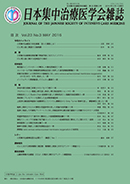Volume 23, Issue 3
Displaying 1-24 of 24 articles from this issue
- |<
- <
- 1
- >
- >|
-
2016Volume 23Issue 3 Pages 293
Published: May 01, 2016
Released on J-STAGE: May 02, 2016
Download PDF (85K)
HIGHLIGHTS IN THIS ISSUE
-
2016Volume 23Issue 3 Pages 295-297
Published: May 01, 2016
Released on J-STAGE: May 02, 2016
Download PDF (236K) -
2016Volume 23Issue 3 Pages 298-299
Published: May 01, 2016
Released on J-STAGE: May 02, 2016
Download PDF (182K)
ORIGINAL ARTICLES
-
2016Volume 23Issue 3 Pages 301-305
Published: May 01, 2016
Released on J-STAGE: May 02, 2016
Download PDF (305K) -
2016Volume 23Issue 3 Pages 306-311
Published: May 01, 2016
Released on J-STAGE: May 02, 2016
Download PDF (315K)
CASE REPORTS
-
2016Volume 23Issue 3 Pages 313-317
Published: May 01, 2016
Released on J-STAGE: May 02, 2016
Download PDF (293K) -
2016Volume 23Issue 3 Pages 318-323
Published: May 01, 2016
Released on J-STAGE: May 02, 2016
Download PDF (716K) -
2016Volume 23Issue 3 Pages 324-327
Published: May 01, 2016
Released on J-STAGE: May 02, 2016
Download PDF (519K) -
2016Volume 23Issue 3 Pages 328-332
Published: May 01, 2016
Released on J-STAGE: May 02, 2016
Download PDF (308K)
BRIEF REPORTS
-
2016Volume 23Issue 3 Pages 333-334
Published: May 01, 2016
Released on J-STAGE: May 02, 2016
Download PDF (280K) -
2016Volume 23Issue 3 Pages 335-336
Published: May 01, 2016
Released on J-STAGE: May 02, 2016
Download PDF (260K) -
2016Volume 23Issue 3 Pages 337-338
Published: May 01, 2016
Released on J-STAGE: May 02, 2016
Download PDF (307K) -
2016Volume 23Issue 3 Pages 339-340
Published: May 01, 2016
Released on J-STAGE: May 02, 2016
Download PDF (225K) -
2016Volume 23Issue 3 Pages 341-342
Published: May 01, 2016
Released on J-STAGE: May 02, 2016
Download PDF (338K) -
2016Volume 23Issue 3 Pages 343-344
Published: May 01, 2016
Released on J-STAGE: May 02, 2016
Download PDF (475K) -
2016Volume 23Issue 3 Pages 345-346
Published: May 01, 2016
Released on J-STAGE: May 02, 2016
Download PDF (250K) -
2016Volume 23Issue 3 Pages 347-348
Published: May 01, 2016
Released on J-STAGE: May 02, 2016
Download PDF (362K) -
2016Volume 23Issue 3 Pages 349-350
Published: May 01, 2016
Released on J-STAGE: May 02, 2016
Download PDF (265K) -
2016Volume 23Issue 3 Pages 351-352
Published: May 01, 2016
Released on J-STAGE: May 02, 2016
Download PDF (222K) -
2016Volume 23Issue 3 Pages 353-354
Published: May 01, 2016
Released on J-STAGE: May 02, 2016
Download PDF (351K) -
2016Volume 23Issue 3 Pages 355-356
Published: May 01, 2016
Released on J-STAGE: May 02, 2016
Download PDF (274K)
LETTER
-
2016Volume 23Issue 3 Pages 357-358
Published: May 01, 2016
Released on J-STAGE: May 02, 2016
Download PDF (176K)
INVESTIGATION REPORT
-
2016Volume 23Issue 3 Pages 359-363
Published: May 01, 2016
Released on J-STAGE: May 02, 2016
Download PDF (443K)
COMMITTEE REPORT
-
2016Volume 23Issue 3 Pages 365-369
Published: May 01, 2016
Released on J-STAGE: May 02, 2016
Download PDF (541K)
- |<
- <
- 1
- >
- >|
